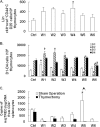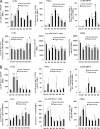Thymopoietic and bone marrow response to murine Pneumocystis pneumonia
- PMID: 21343353
- PMCID: PMC3088129
- DOI: 10.1128/IAI.01213-10
Thymopoietic and bone marrow response to murine Pneumocystis pneumonia
Abstract
CD4(+) T cells play a key role in host defense against Pneumocystis infection. To define the role of naïve CD4(+) T cell production through the thymopoietic response in host defense against Pneumocystis infection, Pneumocystis murina infection in the lung was induced in adult male C57BL/6 mice with and without prior thymectomy. Pneumocystis infection caused a significant increase in the number of CCR9(+) multipotent progenitor (MPP) cells in the bone marrow and peripheral circulation, an increase in populations of earliest thymic progenitors (ETPs) and double negative (DN) thymocytes in the thymus, and recruitment of naïve and total CD4(+) T cells into the alveolar space. The level of murine signal joint T cell receptor excision circles (msjTRECs) in spleen CD4(+) cells was increased at 5 weeks post-Pneumocystis infection. In thymectomized mice, the numbers of naïve, central memory, and total CD4(+) T cells in all tissues examined were markedly reduced following Pneumocystis infection. This deficiency of naïve and central memory CD4(+) T cells was associated with delayed pulmonary clearance of Pneumocystis. Extracts of Pneumocystis resulted in an increase in the number of CCR9(+) MPPs in the cultured bone marrow cells. Stimulation of cultured bone marrow cells with ligands to Toll-like receptor 2 ([TLR-2] zymosan) and TLR-9 (ODN M362) each caused a similar increase in CCR9(+) MPP cells via activation of the Jun N-terminal protein kinase (JNK) pathway. These results demonstrate that enhanced production of naïve CD4(+) T lymphocytes through the thymopoietic response and enhanced delivery of lymphopoietic precursors from the bone marrow play an important role in host defense against Pneumocystis infection.
Figures








Similar articles
-
Identification of a bone marrow precursor of the earliest thymocytes in adult mouse.Proc Natl Acad Sci U S A. 2007 Apr 10;104(15):6311-6. doi: 10.1073/pnas.0609608104. Epub 2007 Apr 2. Proc Natl Acad Sci U S A. 2007. PMID: 17404232 Free PMC article.
-
Involvement of CCR9 at multiple stages of adult T lymphopoiesis.J Leukoc Biol. 2008 Jan;83(1):156-64. doi: 10.1189/jlb.0607423. Epub 2007 Oct 2. J Leukoc Biol. 2008. PMID: 17911179
-
Treatment with Interleukin-7 Restores Host Defense against Pneumocystis in CD4+ T-Lymphocyte-Depleted Mice.Infect Immun. 2015 Oct 19;84(1):108-19. doi: 10.1128/IAI.01189-15. Print 2016 Jan. Infect Immun. 2015. PMID: 26483405 Free PMC article.
-
Lymphocytes in host defense against Pneumocystis carinii.Semin Respir Infect. 1998 Dec;13(4):330-8. Semin Respir Infect. 1998. PMID: 9872630 Review.
-
Some endocrine aspects of the thymus gland.Jpn J Med Sci Biol. 1976 Dec;29(6):289-321. doi: 10.7883/yoken1952.29.289. Jpn J Med Sci Biol. 1976. PMID: 67231 Review.
Cited by
-
Pneumocystis Pneumonia: Pitfalls and Hindrances to Establishing a Reliable Animal Model.J Fungi (Basel). 2022 Jan 27;8(2):129. doi: 10.3390/jof8020129. J Fungi (Basel). 2022. PMID: 35205883 Free PMC article. Review.
-
Immune mechanisms of Concanavalin A model of autoimmune hepatitis.World J Gastroenterol. 2012 Jan 14;18(2):119-25. doi: 10.3748/wjg.v18.i2.119. World J Gastroenterol. 2012. PMID: 22253517 Free PMC article. Review.
-
Oral Immunization of Mice with Live Pneumocystis murina Protects against Pneumocystis Pneumonia.J Immunol. 2016 Mar 15;196(6):2655-65. doi: 10.4049/jimmunol.1502004. Epub 2016 Feb 10. J Immunol. 2016. PMID: 26864029 Free PMC article.
-
Prevalence and Risk Factors of Cytopenia in HIV-Infected Patients before and after the Initiation of HAART.Biomed Res Int. 2020 Jan 28;2020:3132589. doi: 10.1155/2020/3132589. eCollection 2020. Biomed Res Int. 2020. PMID: 32090076 Free PMC article.
-
Analysis of the intestinal microbial community and inferred functional capacities during the host response to Pneumocystis pneumonia.Exp Lung Res. 2016 Oct-Dec;42(8-10):425-439. doi: 10.1080/01902148.2016.1258442. Epub 2016 Dec 7. Exp Lung Res. 2016. PMID: 27925857 Free PMC article.
References
-
- Akashi K., Traver D., Miyamoto T., Weissman I. L. 2000. A clonogenic common myeloid progenitor that gives rise to all myeloid lineages. Nature 404:193–197 - PubMed
-
- Akashi K. 2007. Cartography of hematopoietic stem cell commitment dependent upon a reporter for transcription factor activation. Ann. N. Y. Acad. Sci. 1106:76–81 - PubMed
-
- Allman D., et al. 2003. Thymopoiesis independent of common lymphoid progenitors. Nat. Immunol. 4:168–174 - PubMed
-
- Beq S., et al. 2006. IL-7 induces immunological improvement in SIV-infected rhesus macaques under antiviral therapy. J. Immunol. 176:914–922 - PubMed
-
- Choyke P. L., et al. 1987. Thymic atrophy and regrowth in response to chemotherapy: CT evaluation. AJR Am. J. Roentgenol. 149:269–272 - PubMed
Publication types
MeSH terms
Grants and funding
LinkOut - more resources
Full Text Sources
Medical
Research Materials
Miscellaneous

